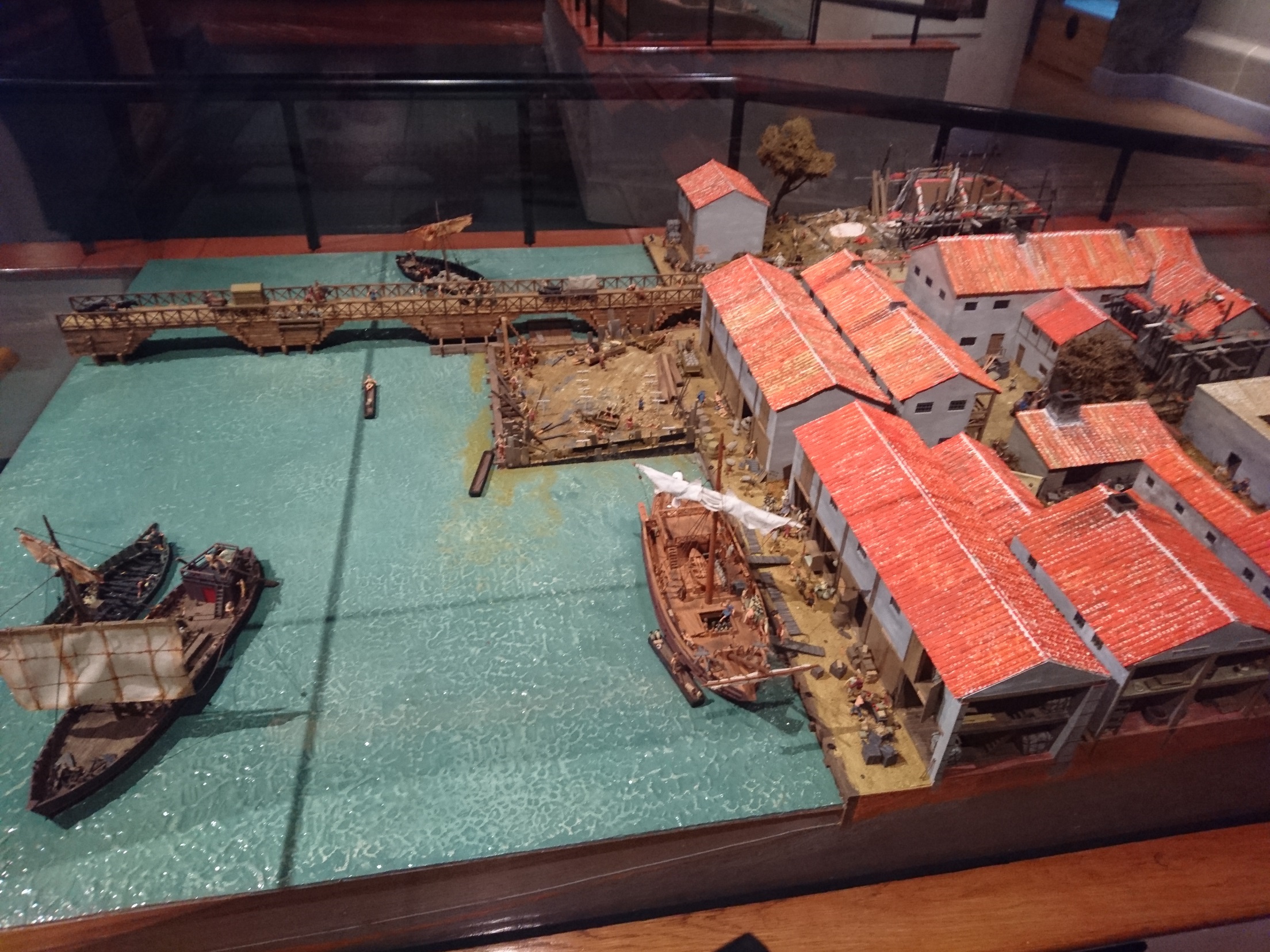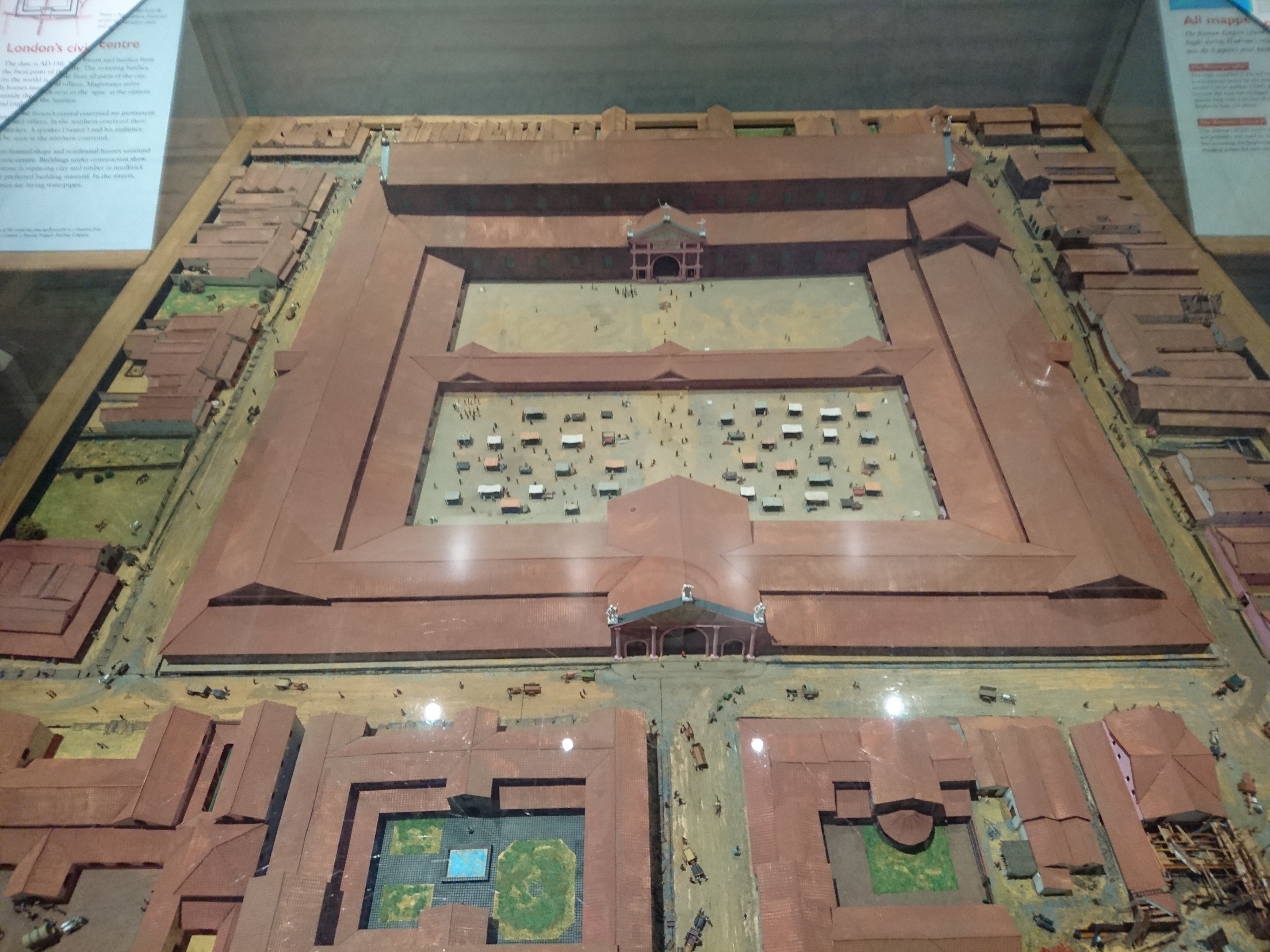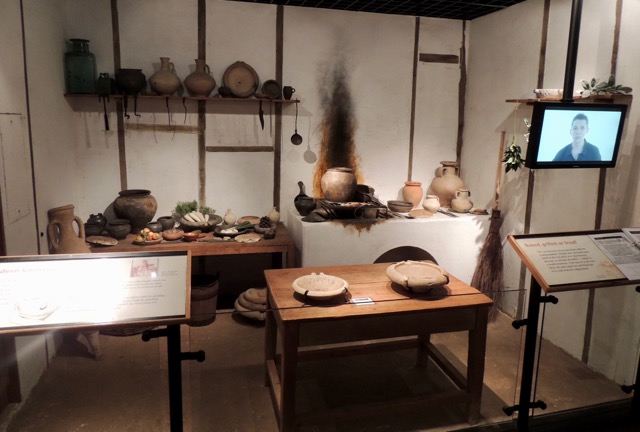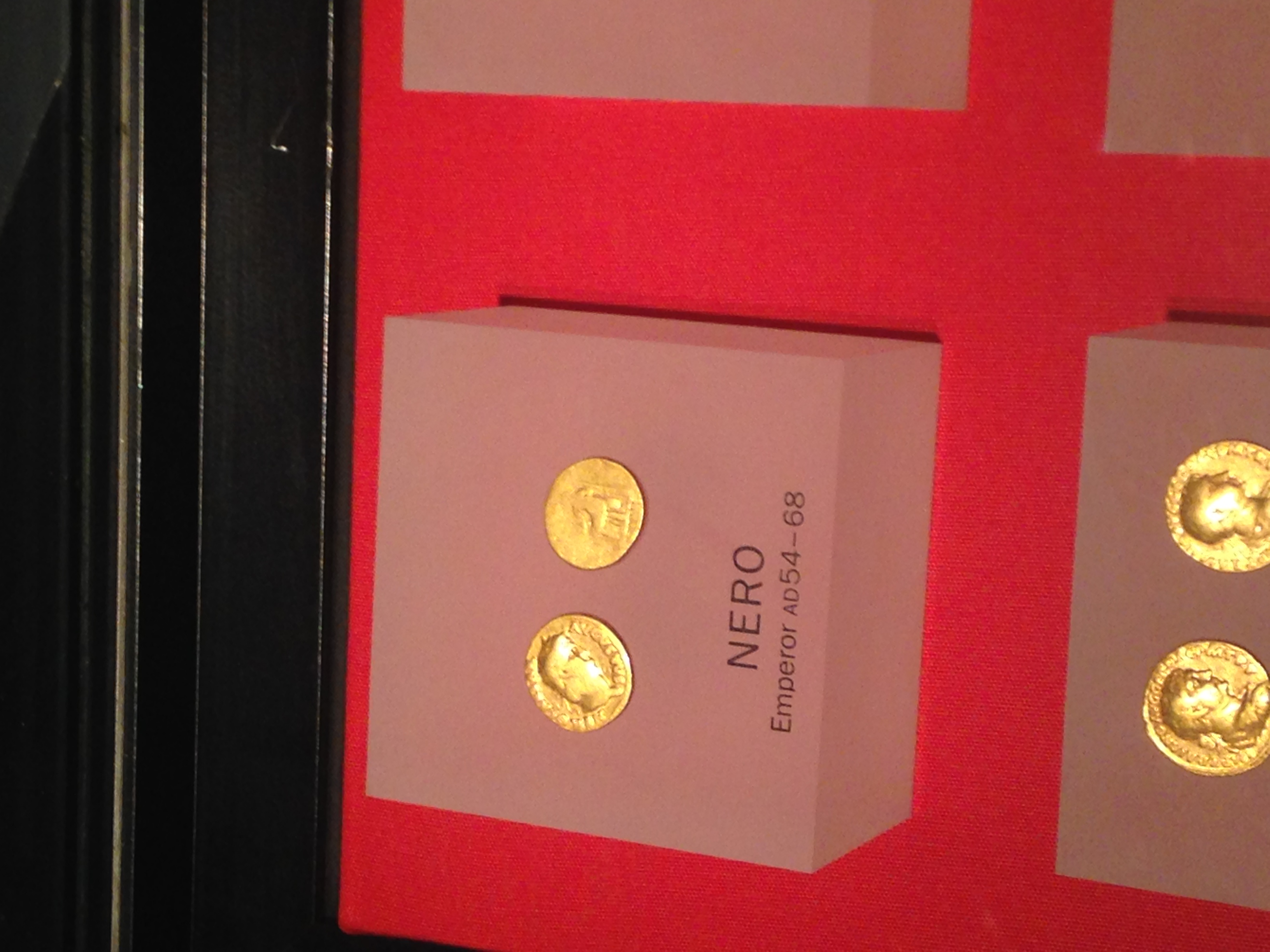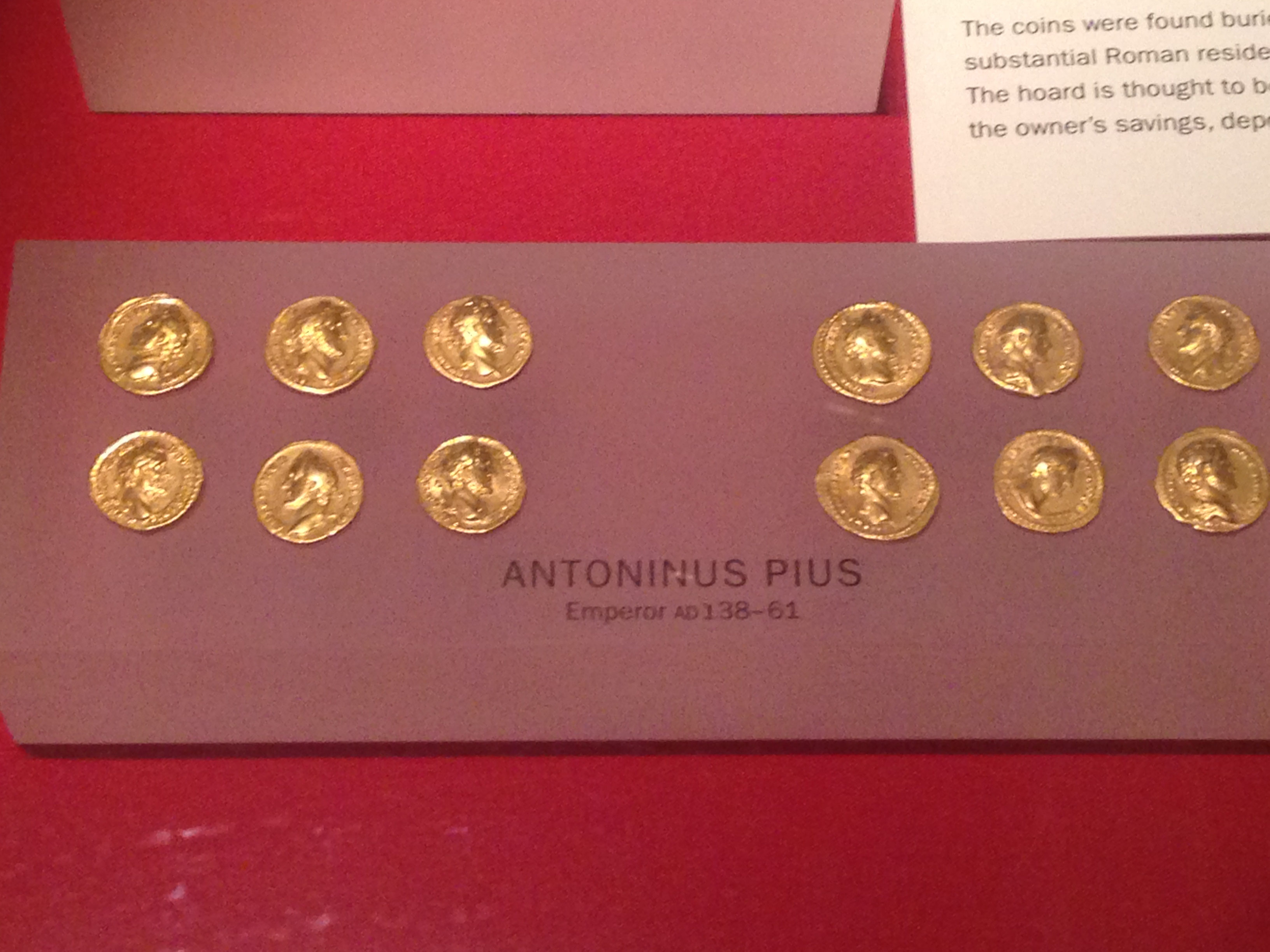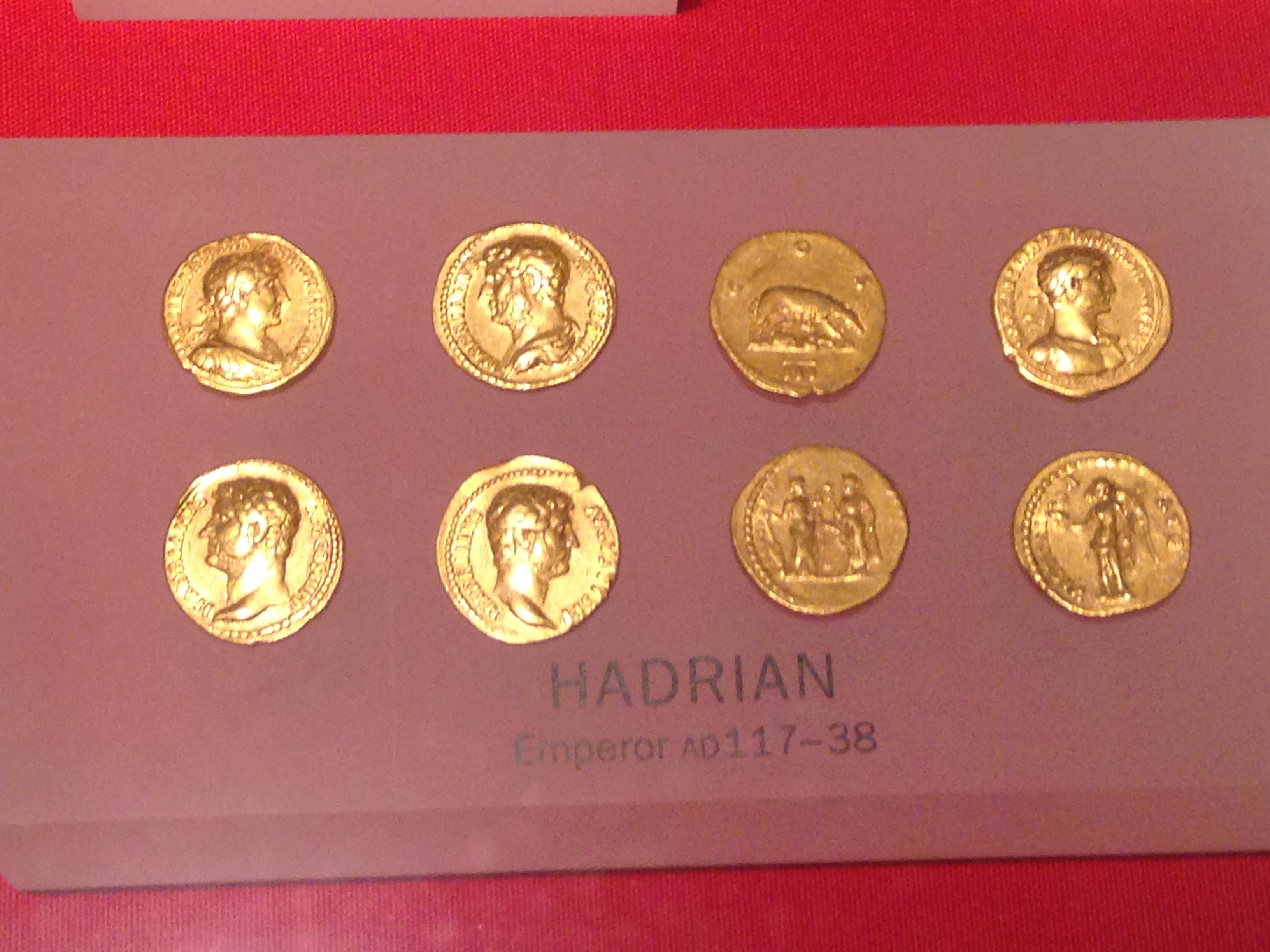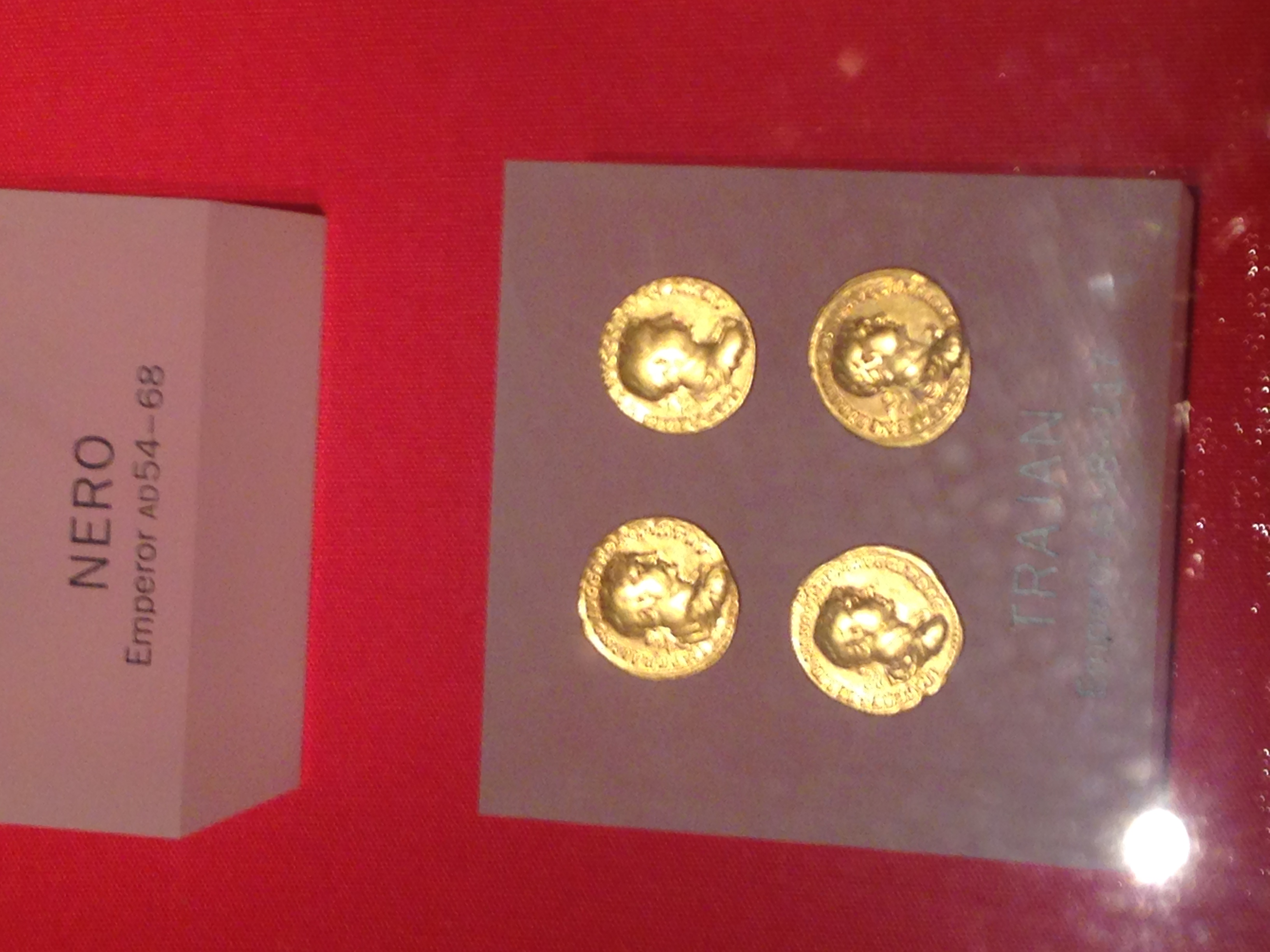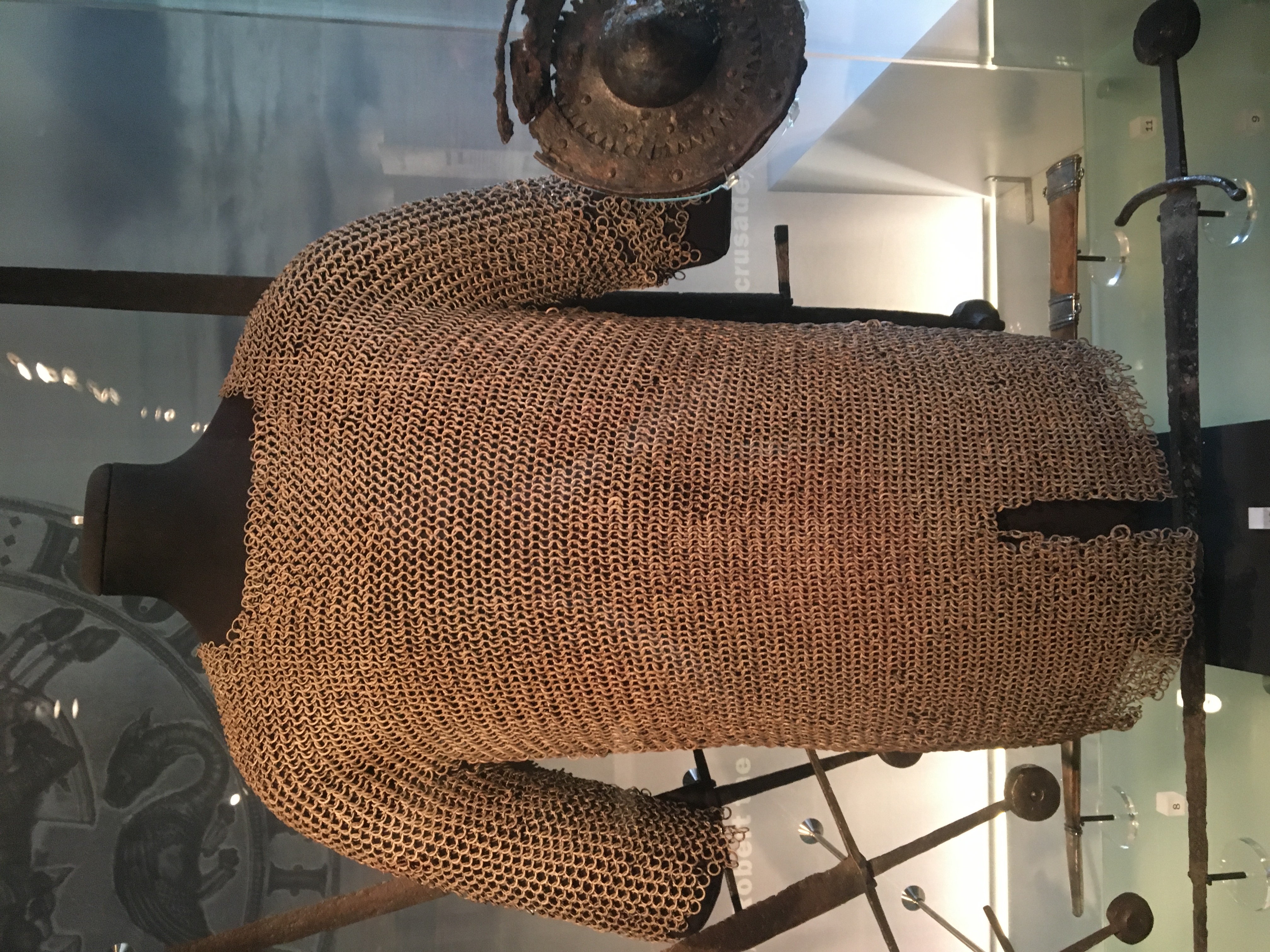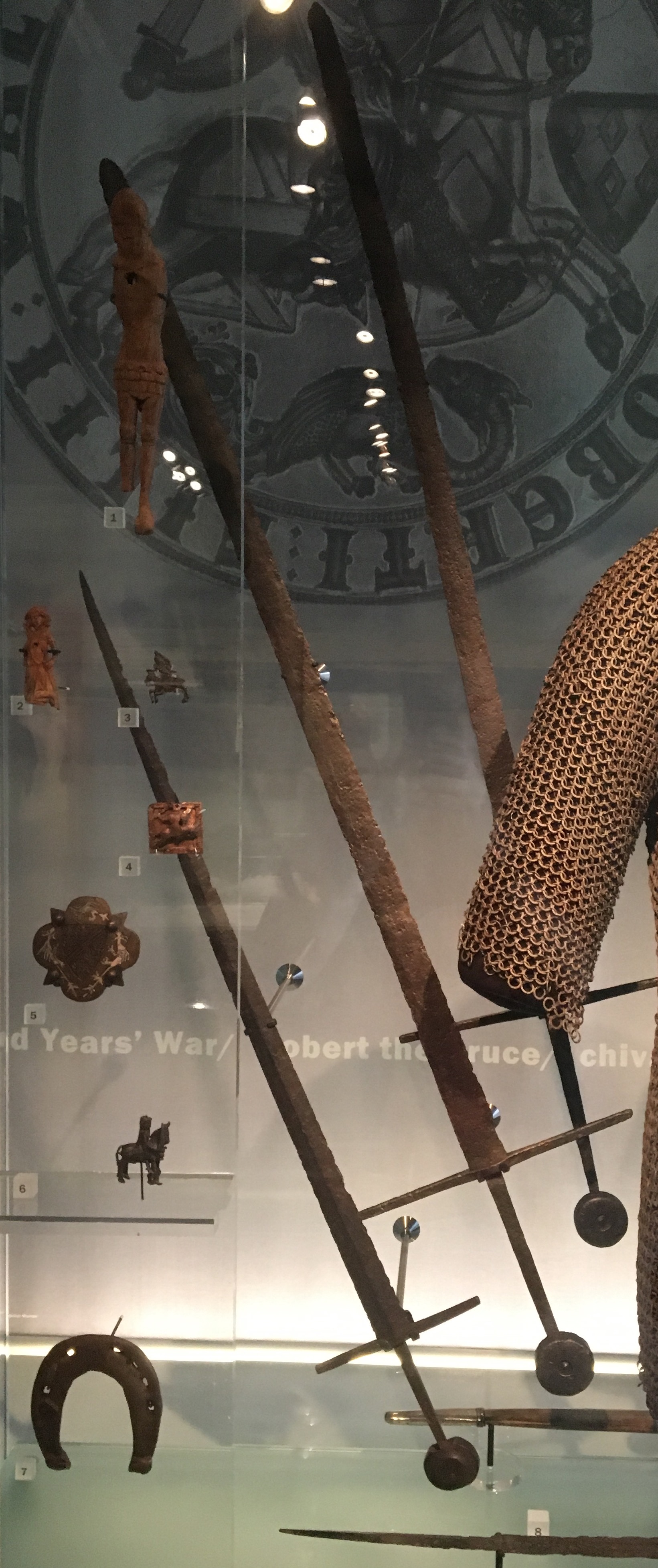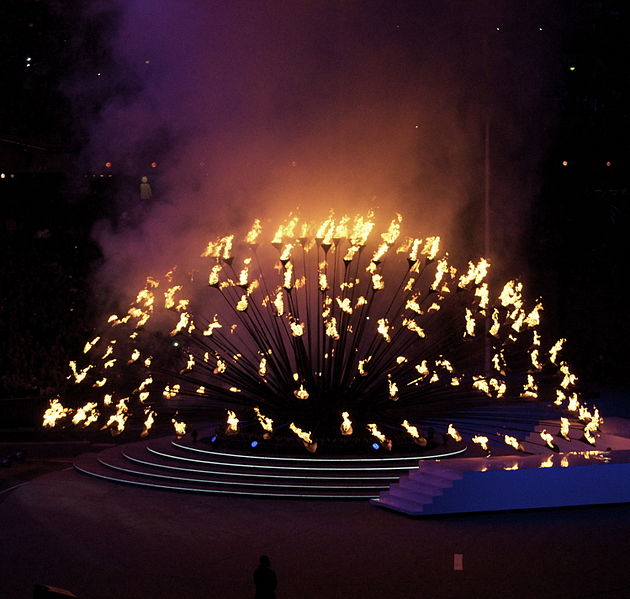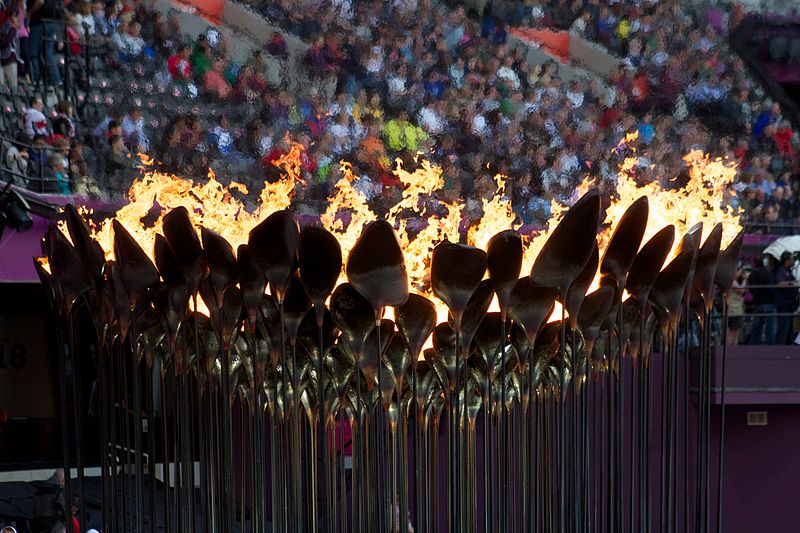Difference between revisions of "Museum of London"
From Londonhua WIKI
Akgiacoman (talk | contribs) |
Mthatfalvi (talk | contribs) |
||
| (63 intermediate revisions by 19 users not shown) | |||
| Line 3: | Line 3: | ||
{{Infobox | {{Infobox | ||
|title = Museum of London | |title = Museum of London | ||
| − | |header1 = The | + | |header1 = The Corner of London Wall and Aldersgate |
| − | of | ||
|bodystyle = width:25em | |bodystyle = width:25em | ||
| − | |image = [[File: | + | |image = [[File:Museum of London.jpg|400px|x450px|alt=Article Image]] |
| − | + | |label2 = '''Credit:''' | |
| − | |label2 = ''' | + | |data2 = Copyright [http://www.geograph.org.uk/profile/1777 Christine Matthews] and licensed for reuse under this [https://creativecommons.org/licenses/by-sa/2.0/ Creative Commons Licence] |
| − | |data2 = | ||
| − | |||
| − | |||
| − | |||
| − | |||
| − | |||
| − | |||
| − | |||
}} | }} | ||
| − | |||
| − | |||
| − | |||
=Overview= | =Overview= | ||
| − | The | + | <br> |
| + | The Museum of London explores the history of London and its surrounding areas from prehistoric times up through to the present. The Museum of London has received multiple awards for its work over the years, including the 2012 European Museum of the Year award<ref>Awards. (n.d.). Retrieved May 15, 2017, from https://www.museumoflondon.org.uk/about-us/our-organisation/awards</ref>. | ||
<br><br> | <br><br> | ||
__TOC__ | __TOC__ | ||
<br> | <br> | ||
| − | + | =The Exhibits at the Museum of London= | |
| − | |||
<br><br> | <br><br> | ||
| − | == | + | ==London Before London== |
| + | This exhibit details the time period when humans first arrived in the area today known as London about 450,000 B.C. to the arrival of the Romans in 50 A.D. The exhibit describes the people living here as nomadic hunters and gatherers. It also goes into detail describing the landscape and inhabiting animals as being very different than it is today. Many glass cases house the bones of different animals that had inhabited the area. The museum also has a fair display of tools, weapons, and human remains that are from the time period. One emphasis of the exhibit details the transition from the bronze age to the stone age. <ref>Pisano, S. (Ed.). (2016). Museum of London: Museum Highlights . London: Scala Arts & Heritage.</ref> | ||
<br> | <br> | ||
| − | + | <br> | |
| + | ===Trade in London=== | ||
| + | Trade was a large part of developing London. Goods were imported from all over Britain to be used in London because immigrants in London required the same food and services found in other parts of Britain. This caused London to flourish with verity of services and food constructed in a single location. <br /> | ||
| + | Britain also imported and exported good to parts of Europe and Asia through London. This caused London expand by build supporting infrastructure such as trade ports and market places. Along with expansion of London, international trade also influenced the philosophical aspects of life in London. | ||
| + | <gallery mode="packed"> | ||
| + | TradePort.jpeg | ||
| + | EarlyLondonMarket.jpeg | ||
| + | </gallery> | ||
| + | <br> | ||
| + | ==Roman London== | ||
| + | <br> | ||
| + | In 43 AD, the Roman Empire annexed London from Britain and London became known as Londinium. This area was divided into two by the Thames River and it became the communication and trading hub for the entire region. The entirety of Londinium was destroyed in 60 AD but rebuild by 100 AD. After the rebuild it became the most prominent city in the region. It contained a port, basilica, public baths, forum and much more. The region became myriad of different cultures and traditions. | ||
| + | <br> <br> | ||
| + | ===Civic Centers=== | ||
| + | In a traditional Roman fashion, Londinium had a central forum and basilica as a main hub of the city. The basilica houses municipal offices and stands as a city landmark, towering over all other buildings. The forum houses shops and offices along the sides of its central courtyard and a market in the southern courtyard. outside the boundaries of these buildings lies houses and other open air shops. The Romans built these government offices along the Thames, allowing easy port access. | ||
<br><br> | <br><br> | ||
| − | + | ===The Kitchen=== | |
| − | <br><br> | + | In London most of the food was supplied by villa estates, which included fresh meat, cereals, fruits and vegetables. Historians believe that the land immediately surrounding London was farmed as allotments by Londoners. There was an abundant amount of both fresh and saltwater available as well. Besides fresh food, there was a demand in the city for ready made food as well. They would grind flour within the city by donkey, or house powered millstones and water-driven millstones. There were are bakers ovens that were large enough to produce bread and cakes commercially. |
| − | + | <br> <br> | |
| − | =The | + | Pictured below is a reconstructed dining room. You can see on the oven ceramic and pots and metal pans, with slow burning charcoal beneath. A fire was lit in the oven below, when bread was cooked they would simply rake out the ashes and cook in the hot compartment. Cooking in most households in Roman London was done or supervised by women. Wealthy household could hire slaves to cook and clean the kitchen. This kitchen is based on a wealthy household and while the furniture was reconstructed, the objects come from Roman London. |
| − | == | + | |
| − | + | <gallery mode= "packed" > | |
| − | == | + | File:EWRL.jpg|'' Roman London Dining Area'' |
| + | </gallery> | ||
| + | <br> | ||
| + | === Amphitheater === | ||
| + | The Amphitheater in Londinium was a place of leisure and entertainment. It was built in 70 AD in the north-west edge of the city. It formed a circular shape and was originally made of dirt and wood, however, overtime it was rebuilt in stone. The amphitheater had two entrances and some sitting rooms. Its floors were made of a mixture of sand and gravel, which allowed water to drain off into the wood drains below. | ||
| + | <br> <br> | ||
| + | === Entertainment === | ||
| + | In the amphitheater, many came to see events such as animal baiting, wild beast hunts, gladiator fights, acrobats, and boxers. These events gave the general population entainment for an afternoon. Bets were often put on who would win during the gladiator fights. Other forms of entertainment included field sports such as ball games, acrobatics, and wild game hunting. Music and board games were also another form of entertainment. | ||
| + | <br> <br> | ||
| + | ==Coinage== | ||
| + | Gold coins where never put into everyday circulation but were used by administrators, bankers and merchants | ||
| + | <gallery mode="packed"> | ||
| + | Image:Coins 1.JPG | ||
| + | Image:Coins 2.JPG | ||
| + | Image:Coins 3.JPG | ||
| + | Image:Coins 4.JPG | ||
| + | </gallery> | ||
<br><br> | <br><br> | ||
==Medieval London== | ==Medieval London== | ||
| + | London grew to be one of the most important and wealthiest cities in Europe after being destroyed by invasion, famine, fire and disease, and political and religious struggles. The medieval era of London began in 1066 during the Norman Invasion when the Duke of Normandy defeated the English king, Harold Godwinson. After the defeat, the duke decided to move his army to London and surrounded the city. Once resistance was determined to be futile, an order came from London that declared the surrender of London and William, the duke, as king. The rise of this new empire brought many new things to the culture of London. One of the most noticeable was the buildings and architecture. In 1097, the construction lf Westminster Hall began which then became the basis for the Palace of Westminster. Another one of the most noticeable buildings from this era is the Augustinian Priory Church of St Bartholomew-the-Great. Now, only the chancel from this great church survives with the nave being completely demolished. The London Bridge also began its construction in 1176 and remained the only bridge across the River Thames for 600 years. Unfortunately for a lot of other buildings in London, most were made of wood. This and the incredibly narrow roads around the city posed a great fire threat for London. These narrow roads and close-quarters also provided easy transportation for the Black Death in mid-14th century. | ||
| + | |||
| + | ===Chain mail Armor=== | ||
| + | This chain mail armor is from the 1300s and is made up of riveted iron rings. As it was time consuming and expensive to make few soldiers received it and most went into battle with padded leather jackets. | ||
| + | <gallery mode="packed"> | ||
| + | Image: chainmail.JPG | ||
| + | </gallery> | ||
| + | ===Swords=== | ||
| + | The swords pictured below were armored knights' chief weapons. An ordinary London Citizen found to be carrying one of these could have been arrested. Two of these swords were found in the Thames, the others were found at Merton and Barking. | ||
| + | <gallery mode="packed"> | ||
| + | Image: swords.jpg | ||
| + | </gallery> | ||
<br><br> | <br><br> | ||
==War, Plague & Fire== | ==War, Plague & Fire== | ||
| + | This exhibit focuses on the time period between 1550-1660, which is described as one of the most "turbulent" periods of the city's history. The exhibit shows how London had started to become divided, where some people were more concerned with art and Shakespeare's plays and others were evangelical Puritans who wanted to get rid of Shakespeare's theaters all together. The history of the Civil War in London is on display in this gallery and the plague that occurred in 1655, which killed more than 7000 people per week, can also be found here in this gallery. The section of the exhibit that is dedicated to the Great Fire of London is currently under renovation, but there is an interesting short video about the fire. To learn more about this exhibit click [[War, Plague & Fire|here]]. | ||
| + | <br><br> | ||
| + | |||
==Expanding City== | ==Expanding City== | ||
| + | In the 1660s-1850s The years following the Great Fire heralded the start of a new chapter in London's story. The city expanded on the ground and its influence spread across the globe. London became capital not only of a 'united kingdom' but also of a vast empire. In size and population, wealth and power, there had never been a city like it. All aspects of London grew phenomenally from 1666. Printing presses multiplied and Londoners developed an appetite for newspapers, ideas and debate. London was also Britain's largest manufacturing centre, noted particularly for its specialist products such as watches and scientific instruments. By the 185os Queen promoting England as the workshop of the world. By now London had long overtaken Paris as Europe's largest city. It was a busy and chaotic place, a confident city that thrived on free enterprise. People were drawn to London from all parts of the world and the massive new docks handled unprecedented quantities of cargo. This London was a city of amusement as well as hardship. Pleasure gardens, theatres and music halls thrived in the capital, alongside workshops, warehouses and prisons. | ||
| + | <br><br> | ||
| + | After the Plague of 1866 and the Great Fire of 1866, recovered rapidly. By the 1700s had overtaken Paris as Europe's largest city, London would become capital not only of a and 'united kingdom' but of a vast empire. In size population, wealth and power, there had never been a like it. London was a busy and chaotic place, a confident city that thrived on free enterprise, People were drawn to London from all parts of the world, Many fled religious persecution or famine. Immigrants brought new skills that benefited the business and cultural life of the city, More Londoners became literate. They read newspapers and debated new ideas. Thousands of books and pamphlets were published each year. Liberty!' was rallying cry of the people, who were politically freer than in other European cities. | ||
| + | | ||
| + | |||
==The Victorian Walk== | ==The Victorian Walk== | ||
| + | The Victorian Walk is an exhibit at the Museum of London that takes you through the streets during the Victorian Era in London. The walk brings you past multiple different streets with shops lined up along each side of the street. There is music playing in the background that replays the sounds from walking through the busy streets. To learn more about the Victorian Walk exhibit, click [[Victorian Walk|here]]. | ||
| + | <br><br> | ||
| + | |||
==People's City== | ==People's City== | ||
| + | <br><br> | ||
| + | ==Charles Booth's map of poverty 1887's to 1889's== | ||
| + | This exhibit is located within the Modern London 1850-1940 People's City exhibit and show cases the need for social justice and compassion towards the poor. He recognized the limitations of philanthropy and conditional charity when addressing the poverty which scarred British society. Without any commission other than his own he devised, organized, and funded one of the most comprehensive and scientific social surveys of London life that had then been undertaken. His research was organized into three broad sections: poverty, industry and religious influences. The poverty series gathered information from the School Board Visitors about the levels of poverty and types of occupation among the families for which they were responsible. He served on several commissions such as the Royal Commission on the Aged Poor and the Royal Commission on the Poor Law, both of which stayed out of politics. | ||
| + | <br><br> | ||
| + | The ''Maps Descriptive of London Poverty'' is one of the most comprehensive maps of poverty in London at the time. They identify the class which the poor are in, the age group, and their desire for help. A combination of colours on the map identified a mix of different classes. The 12 Maps Descriptive of London Poverty, 1898-9 cover an area of London from Hammersmith in the west, to Greenwich in the east, and from Hampstead in the north to Clapham in the south. There is a possible 13th sheet covering Woolworth at the LSE Library. | ||
| + | <br><br> | ||
| + | |||
==World City== | ==World City== | ||
| + | <br> | ||
| + | After World War II, London was not as strong a city as it once was. Population was in decline and The British Empire had lost its colonies. Along with these factors the London youth and the multicultural community staged revolutions. These revolutions were brought on by the absorption of new values and claimed to have new rights. By the end of the 20<sup>th</sup> century London's identity was as diverse as its people. To learn more about the World City click [[World City|here.]] | ||
| + | <br><br> | ||
| + | |||
==The Lord Major's Coach== | ==The Lord Major's Coach== | ||
| + | [[File:Lord Mayor of London - John Stuttard - Nov 2006.jpg|400px|right|thumb|John Stuttard, Lord Mayor of London (2006) <br><small> '''Attributed to''' By Diliff (Own work) [GFDL (http://www.gnu.org/copyleft/fdl.html), CC-BY-SA-3.0 (http://creativecommons.org/licenses/by-sa/3.0/) or CC BY 2.5 (http://creativecommons.org/licenses/by/2.5)], via Wikimedia Commons - [https://commons.wikimedia.org/wiki/File%3ALord_Mayor_of_London_-_John_Stuttard_-_Nov_2006.jpg Link]]] | ||
| + | The Lord Major's Coach is used in the annual procession of the Lord Major of London which has been a reoccurring custom every year since the early 13th century.<ref name="MoL" > Lord Mayor's Coach - About this Object - Museum of London. (2017, January 21). Retrieved May 19, 2017, from http://collections.museumoflondon.org.uk/online/object/478907.html</ref> Starting in the 13th century though, the Lord Major rode on horseback till the 1420's, then by water until 1857.<ref name="MoL"/> According to the Museum website, in 1757 Sir Charles Asgill the future Lord Mayor at the time persuaded the Aldermen to give money for a ‘New Grand State Coach’ that he could use in the procession.<ref name="MoL"/> A coach was then ordered from Joseph Berry for £860 and was used for Sir Charles Asgill's Lord Major procession.<ref name="MoL"/> The coach was designed by Sir Robert Taylor though many people such as carpenters, tailors, wheelers, carvers and painters were given the opportunity to make the carriage.<ref name="MoL"/> According to the Museum of London, the design of the coach shows the importance of London’s port and the city’s trade.<ref name="MoL"/> The coachman’s seat is supported by mythical sea creatures and is supported at each corner by child angels that represent the four known continents: Asia, Africa, America and Europe and the London's coat of arms is decorated on the back of the coach.<ref name="MoL"/> Also, according to the Museum of London, three of the main coach panels show London's guardian spirit.<ref name="MoL"/> On the front panel there is a female figure that represents Hope and points at the dome of St Paul’s cathedral.<ref name="MoL"/> And lastly, according to the Museum of London, the smaller side panels represent the virtues: Truth, Temperance, Justice and Fortitude. <ref name="MoL"/> The coach has gone through a lot of changes since it was first built. | ||
| + | <br><br> | ||
| + | |||
==The London 2012 Cauldron== | ==The London 2012 Cauldron== | ||
| + | <br> | ||
| + | This exhibit features the Olympic Cauldron used in the 2012 London Olympic Games. The exhibit shows how the Cauldron was designed, built, and put to use. At the center of the exhibit is the cauldron itself, shown in both half-open and closed positions<ref>The London 2012 Cauldron. (n.d.). Retrieved May 15, 2017, from https://www.museumoflondon.org.uk/museum-london/permanent-galleries/london-2012-cauldron</ref>. | ||
| + | <br><br> | ||
| + | The Cauldron was designed by Thomas Heatherwick and made by Heatherwick Studio under deep secrecy, not being revealed to the public until Opening Ceremonies. The secret of the Cauldron's design was kept so secret that it was codenamed Betty, and designers in the studio were never allowed to have more than one small section of the Cauldron up on their screens at once, reducing the risk that anyone watching might figure out what the entire project was. Before the Games, the Cauldron was secretly tested in the Olympic Stadium in the middle of the night<ref>The London 2012 Cauldron. (n.d.). Retrieved May 15, 2017, from https://www.museumoflondon.org.uk/museum-london/permanent-galleries/london-2012-cauldron</ref>. Each petal was custom made and not two are the same, with the construction of a single one taking two days. The graceful design has since been described as "one of the most original in the history of the Games<ref>Wainwright, O. (2014, July 23). Row over Olympic cauldron design settled out of court. The Guardian. Retrieved May 15, 2017, from https://www.theguardian.com/artanddesign/2014/jul/23/locog-settle-with-atopia-over-olympic-cauldron-opening-ceremony</ref>. | ||
| + | <gallery mode="packed"> | ||
| + | Image:2012 Olympic Cauldron Open.jpg | ||
| + | Image:2012_Olympic_Cauldron_Closed.jpg | ||
| + | </gallery> | ||
| + | <br><br> | ||
| + | |||
| + | ==Present Day== | ||
| + | As the timeline the museum follows reaches present day, there are exhibits meant to reflect current life in London. These exhibits encourage visitor participation. The exhibits are designed to give insight into everyday life in London through the voices and actions of the citizens. | ||
| + | ===Blast Theory=== | ||
| + | Blast Theory captures the voices of the people of London to give insight into the future of London. The display consists of video footage of London with voice overs from citizens speaking about what London means to them. For example, the footage of parks is accompanied by personal stories about visiting the parks and people's appreciation for them. Visitors are encouraged to record their own voice overs to be added to the display in reaction to what they have seen. | ||
| + | ===Lady Lucy=== | ||
| + | This exhibit captures the people of London and the positive impact they can make on others. Lady Lucy paints watercolor portraits of visitors in exchange for some form of gift for another. These gifts can be services or material items. These gifts are then given to others who apply. The display shows such positive connections between people that make up everyday life. | ||
| + | <br><br> | ||
| + | |||
| + | ==The London Stone== | ||
| + | The London stone was first referenced around 1100. The date of the mysterious stone is unknown, and its purpose is also unclear. Many interesting stories surround the stone throughout its existence. In 1450, Jack Cade, leader of the rebellion against King Henry VI, hit the stone, claiming to be Lord of the City. Cade died later that year. | ||
| + | <br><br> | ||
| + | In 1671, the Worshipful Company of Spectacle Makers destroyed a a batch of two hundred and sixty four poorly-made spectacles upon the stone, to make an example out of the poor craftsmanship. | ||
| + | <br><br> | ||
| + | While many explanations are given to the stones purpose, there is no substantial proof behind any of them, making the stone that much more mysterious. | ||
| + | <br><br> | ||
| + | |||
| + | |||
=References= | =References= | ||
| − | + | <br> | |
| + | |||
| + | <references/> | ||
| + | |||
<br><br> | <br><br> | ||
| + | |||
=External Links= | =External Links= | ||
If appropriate, add an external links section | If appropriate, add an external links section | ||
| Line 67: | Line 155: | ||
[[Category:History]] | [[Category:History]] | ||
[[Category:English]] | [[Category:English]] | ||
| − | |||
| − | |||
| − | |||
| − | |||
Latest revision as of 17:54, 21 June 2017
Museum of London
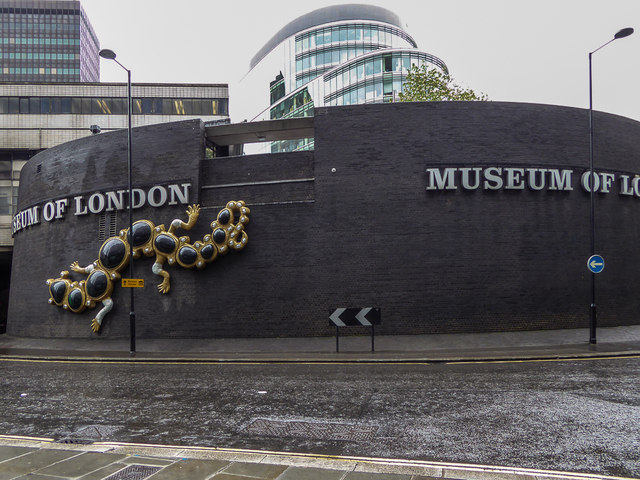 | |
| The Corner of London Wall and Aldersgate | |
|---|---|
| Credit: | Copyright Christine Matthews and licensed for reuse under this Creative Commons Licence |
Overview
The Museum of London explores the history of London and its surrounding areas from prehistoric times up through to the present. The Museum of London has received multiple awards for its work over the years, including the 2012 European Museum of the Year award[1].
Contents
- 1 Museum of London
- 2 Overview
- 3 The Exhibits at the Museum of London
- 3.1 London Before London
- 3.2 Roman London
- 3.3 Coinage
- 3.4 Medieval London
- 3.5 War, Plague & Fire
- 3.6 Expanding City
- 3.7 The Victorian Walk
- 3.8 People's City
- 3.9 Charles Booth's map of poverty 1887's to 1889's
- 3.10 World City
- 3.11 The Lord Major's Coach
- 3.12 The London 2012 Cauldron
- 3.13 Present Day
- 3.14 The London Stone
- 4 References
- 5 External Links
- 6 Image Gallery
The Exhibits at the Museum of London
London Before London
This exhibit details the time period when humans first arrived in the area today known as London about 450,000 B.C. to the arrival of the Romans in 50 A.D. The exhibit describes the people living here as nomadic hunters and gatherers. It also goes into detail describing the landscape and inhabiting animals as being very different than it is today. Many glass cases house the bones of different animals that had inhabited the area. The museum also has a fair display of tools, weapons, and human remains that are from the time period. One emphasis of the exhibit details the transition from the bronze age to the stone age. [2]
Trade in London
Trade was a large part of developing London. Goods were imported from all over Britain to be used in London because immigrants in London required the same food and services found in other parts of Britain. This caused London to flourish with verity of services and food constructed in a single location.
Britain also imported and exported good to parts of Europe and Asia through London. This caused London expand by build supporting infrastructure such as trade ports and market places. Along with expansion of London, international trade also influenced the philosophical aspects of life in London.
Roman London
In 43 AD, the Roman Empire annexed London from Britain and London became known as Londinium. This area was divided into two by the Thames River and it became the communication and trading hub for the entire region. The entirety of Londinium was destroyed in 60 AD but rebuild by 100 AD. After the rebuild it became the most prominent city in the region. It contained a port, basilica, public baths, forum and much more. The region became myriad of different cultures and traditions.
Civic Centers
In a traditional Roman fashion, Londinium had a central forum and basilica as a main hub of the city. The basilica houses municipal offices and stands as a city landmark, towering over all other buildings. The forum houses shops and offices along the sides of its central courtyard and a market in the southern courtyard. outside the boundaries of these buildings lies houses and other open air shops. The Romans built these government offices along the Thames, allowing easy port access.
The Kitchen
In London most of the food was supplied by villa estates, which included fresh meat, cereals, fruits and vegetables. Historians believe that the land immediately surrounding London was farmed as allotments by Londoners. There was an abundant amount of both fresh and saltwater available as well. Besides fresh food, there was a demand in the city for ready made food as well. They would grind flour within the city by donkey, or house powered millstones and water-driven millstones. There were are bakers ovens that were large enough to produce bread and cakes commercially.
Pictured below is a reconstructed dining room. You can see on the oven ceramic and pots and metal pans, with slow burning charcoal beneath. A fire was lit in the oven below, when bread was cooked they would simply rake out the ashes and cook in the hot compartment. Cooking in most households in Roman London was done or supervised by women. Wealthy household could hire slaves to cook and clean the kitchen. This kitchen is based on a wealthy household and while the furniture was reconstructed, the objects come from Roman London.
Amphitheater
The Amphitheater in Londinium was a place of leisure and entertainment. It was built in 70 AD in the north-west edge of the city. It formed a circular shape and was originally made of dirt and wood, however, overtime it was rebuilt in stone. The amphitheater had two entrances and some sitting rooms. Its floors were made of a mixture of sand and gravel, which allowed water to drain off into the wood drains below.
Entertainment
In the amphitheater, many came to see events such as animal baiting, wild beast hunts, gladiator fights, acrobats, and boxers. These events gave the general population entainment for an afternoon. Bets were often put on who would win during the gladiator fights. Other forms of entertainment included field sports such as ball games, acrobatics, and wild game hunting. Music and board games were also another form of entertainment.
Coinage
Gold coins where never put into everyday circulation but were used by administrators, bankers and merchants
Medieval London
London grew to be one of the most important and wealthiest cities in Europe after being destroyed by invasion, famine, fire and disease, and political and religious struggles. The medieval era of London began in 1066 during the Norman Invasion when the Duke of Normandy defeated the English king, Harold Godwinson. After the defeat, the duke decided to move his army to London and surrounded the city. Once resistance was determined to be futile, an order came from London that declared the surrender of London and William, the duke, as king. The rise of this new empire brought many new things to the culture of London. One of the most noticeable was the buildings and architecture. In 1097, the construction lf Westminster Hall began which then became the basis for the Palace of Westminster. Another one of the most noticeable buildings from this era is the Augustinian Priory Church of St Bartholomew-the-Great. Now, only the chancel from this great church survives with the nave being completely demolished. The London Bridge also began its construction in 1176 and remained the only bridge across the River Thames for 600 years. Unfortunately for a lot of other buildings in London, most were made of wood. This and the incredibly narrow roads around the city posed a great fire threat for London. These narrow roads and close-quarters also provided easy transportation for the Black Death in mid-14th century.
Chain mail Armor
This chain mail armor is from the 1300s and is made up of riveted iron rings. As it was time consuming and expensive to make few soldiers received it and most went into battle with padded leather jackets.
Swords
The swords pictured below were armored knights' chief weapons. An ordinary London Citizen found to be carrying one of these could have been arrested. Two of these swords were found in the Thames, the others were found at Merton and Barking.
War, Plague & Fire
This exhibit focuses on the time period between 1550-1660, which is described as one of the most "turbulent" periods of the city's history. The exhibit shows how London had started to become divided, where some people were more concerned with art and Shakespeare's plays and others were evangelical Puritans who wanted to get rid of Shakespeare's theaters all together. The history of the Civil War in London is on display in this gallery and the plague that occurred in 1655, which killed more than 7000 people per week, can also be found here in this gallery. The section of the exhibit that is dedicated to the Great Fire of London is currently under renovation, but there is an interesting short video about the fire. To learn more about this exhibit click here.
Expanding City
In the 1660s-1850s The years following the Great Fire heralded the start of a new chapter in London's story. The city expanded on the ground and its influence spread across the globe. London became capital not only of a 'united kingdom' but also of a vast empire. In size and population, wealth and power, there had never been a city like it. All aspects of London grew phenomenally from 1666. Printing presses multiplied and Londoners developed an appetite for newspapers, ideas and debate. London was also Britain's largest manufacturing centre, noted particularly for its specialist products such as watches and scientific instruments. By the 185os Queen promoting England as the workshop of the world. By now London had long overtaken Paris as Europe's largest city. It was a busy and chaotic place, a confident city that thrived on free enterprise. People were drawn to London from all parts of the world and the massive new docks handled unprecedented quantities of cargo. This London was a city of amusement as well as hardship. Pleasure gardens, theatres and music halls thrived in the capital, alongside workshops, warehouses and prisons.
After the Plague of 1866 and the Great Fire of 1866, recovered rapidly. By the 1700s had overtaken Paris as Europe's largest city, London would become capital not only of a and 'united kingdom' but of a vast empire. In size population, wealth and power, there had never been a like it. London was a busy and chaotic place, a confident city that thrived on free enterprise, People were drawn to London from all parts of the world, Many fled religious persecution or famine. Immigrants brought new skills that benefited the business and cultural life of the city, More Londoners became literate. They read newspapers and debated new ideas. Thousands of books and pamphlets were published each year. Liberty!' was rallying cry of the people, who were politically freer than in other European cities.
The Victorian Walk
The Victorian Walk is an exhibit at the Museum of London that takes you through the streets during the Victorian Era in London. The walk brings you past multiple different streets with shops lined up along each side of the street. There is music playing in the background that replays the sounds from walking through the busy streets. To learn more about the Victorian Walk exhibit, click here.
People's City
Charles Booth's map of poverty 1887's to 1889's
This exhibit is located within the Modern London 1850-1940 People's City exhibit and show cases the need for social justice and compassion towards the poor. He recognized the limitations of philanthropy and conditional charity when addressing the poverty which scarred British society. Without any commission other than his own he devised, organized, and funded one of the most comprehensive and scientific social surveys of London life that had then been undertaken. His research was organized into three broad sections: poverty, industry and religious influences. The poverty series gathered information from the School Board Visitors about the levels of poverty and types of occupation among the families for which they were responsible. He served on several commissions such as the Royal Commission on the Aged Poor and the Royal Commission on the Poor Law, both of which stayed out of politics.
The Maps Descriptive of London Poverty is one of the most comprehensive maps of poverty in London at the time. They identify the class which the poor are in, the age group, and their desire for help. A combination of colours on the map identified a mix of different classes. The 12 Maps Descriptive of London Poverty, 1898-9 cover an area of London from Hammersmith in the west, to Greenwich in the east, and from Hampstead in the north to Clapham in the south. There is a possible 13th sheet covering Woolworth at the LSE Library.
World City
After World War II, London was not as strong a city as it once was. Population was in decline and The British Empire had lost its colonies. Along with these factors the London youth and the multicultural community staged revolutions. These revolutions were brought on by the absorption of new values and claimed to have new rights. By the end of the 20th century London's identity was as diverse as its people. To learn more about the World City click here.
The Lord Major's Coach
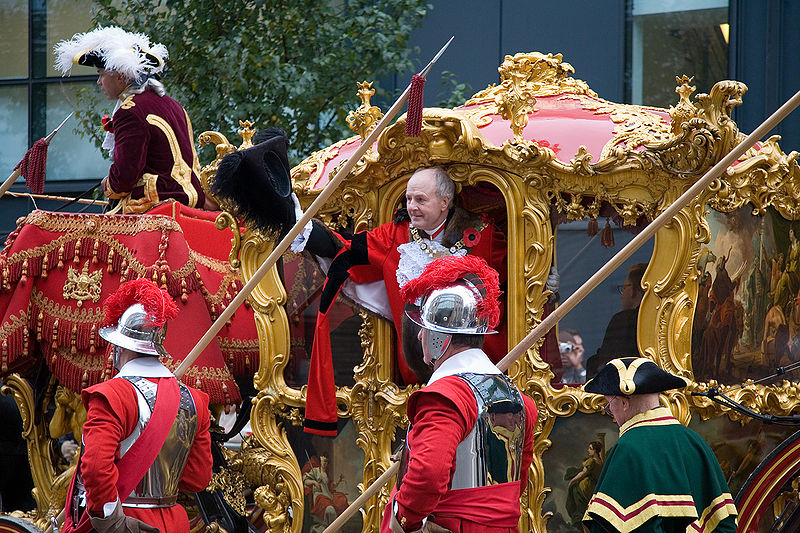
Attributed to By Diliff (Own work) [GFDL (http://www.gnu.org/copyleft/fdl.html), CC-BY-SA-3.0 (http://creativecommons.org/licenses/by-sa/3.0/) or CC BY 2.5 (http://creativecommons.org/licenses/by/2.5)], via Wikimedia Commons - Link
The Lord Major's Coach is used in the annual procession of the Lord Major of London which has been a reoccurring custom every year since the early 13th century.[3] Starting in the 13th century though, the Lord Major rode on horseback till the 1420's, then by water until 1857.[3] According to the Museum website, in 1757 Sir Charles Asgill the future Lord Mayor at the time persuaded the Aldermen to give money for a ‘New Grand State Coach’ that he could use in the procession.[3] A coach was then ordered from Joseph Berry for £860 and was used for Sir Charles Asgill's Lord Major procession.[3] The coach was designed by Sir Robert Taylor though many people such as carpenters, tailors, wheelers, carvers and painters were given the opportunity to make the carriage.[3] According to the Museum of London, the design of the coach shows the importance of London’s port and the city’s trade.[3] The coachman’s seat is supported by mythical sea creatures and is supported at each corner by child angels that represent the four known continents: Asia, Africa, America and Europe and the London's coat of arms is decorated on the back of the coach.[3] Also, according to the Museum of London, three of the main coach panels show London's guardian spirit.[3] On the front panel there is a female figure that represents Hope and points at the dome of St Paul’s cathedral.[3] And lastly, according to the Museum of London, the smaller side panels represent the virtues: Truth, Temperance, Justice and Fortitude. [3] The coach has gone through a lot of changes since it was first built.
The London 2012 Cauldron
This exhibit features the Olympic Cauldron used in the 2012 London Olympic Games. The exhibit shows how the Cauldron was designed, built, and put to use. At the center of the exhibit is the cauldron itself, shown in both half-open and closed positions[4].
The Cauldron was designed by Thomas Heatherwick and made by Heatherwick Studio under deep secrecy, not being revealed to the public until Opening Ceremonies. The secret of the Cauldron's design was kept so secret that it was codenamed Betty, and designers in the studio were never allowed to have more than one small section of the Cauldron up on their screens at once, reducing the risk that anyone watching might figure out what the entire project was. Before the Games, the Cauldron was secretly tested in the Olympic Stadium in the middle of the night[5]. Each petal was custom made and not two are the same, with the construction of a single one taking two days. The graceful design has since been described as "one of the most original in the history of the Games[6].
Present Day
As the timeline the museum follows reaches present day, there are exhibits meant to reflect current life in London. These exhibits encourage visitor participation. The exhibits are designed to give insight into everyday life in London through the voices and actions of the citizens.
Blast Theory
Blast Theory captures the voices of the people of London to give insight into the future of London. The display consists of video footage of London with voice overs from citizens speaking about what London means to them. For example, the footage of parks is accompanied by personal stories about visiting the parks and people's appreciation for them. Visitors are encouraged to record their own voice overs to be added to the display in reaction to what they have seen.
Lady Lucy
This exhibit captures the people of London and the positive impact they can make on others. Lady Lucy paints watercolor portraits of visitors in exchange for some form of gift for another. These gifts can be services or material items. These gifts are then given to others who apply. The display shows such positive connections between people that make up everyday life.
The London Stone
The London stone was first referenced around 1100. The date of the mysterious stone is unknown, and its purpose is also unclear. Many interesting stories surround the stone throughout its existence. In 1450, Jack Cade, leader of the rebellion against King Henry VI, hit the stone, claiming to be Lord of the City. Cade died later that year.
In 1671, the Worshipful Company of Spectacle Makers destroyed a a batch of two hundred and sixty four poorly-made spectacles upon the stone, to make an example out of the poor craftsmanship.
While many explanations are given to the stones purpose, there is no substantial proof behind any of them, making the stone that much more mysterious.
References
- ↑ Awards. (n.d.). Retrieved May 15, 2017, from https://www.museumoflondon.org.uk/about-us/our-organisation/awards
- ↑ Pisano, S. (Ed.). (2016). Museum of London: Museum Highlights . London: Scala Arts & Heritage.
- ↑ 3.0 3.1 3.2 3.3 3.4 3.5 3.6 3.7 3.8 3.9 Lord Mayor's Coach - About this Object - Museum of London. (2017, January 21). Retrieved May 19, 2017, from http://collections.museumoflondon.org.uk/online/object/478907.html
- ↑ The London 2012 Cauldron. (n.d.). Retrieved May 15, 2017, from https://www.museumoflondon.org.uk/museum-london/permanent-galleries/london-2012-cauldron
- ↑ The London 2012 Cauldron. (n.d.). Retrieved May 15, 2017, from https://www.museumoflondon.org.uk/museum-london/permanent-galleries/london-2012-cauldron
- ↑ Wainwright, O. (2014, July 23). Row over Olympic cauldron design settled out of court. The Guardian. Retrieved May 15, 2017, from https://www.theguardian.com/artanddesign/2014/jul/23/locog-settle-with-atopia-over-olympic-cauldron-opening-ceremony
External Links
If appropriate, add an external links section
Image Gallery
If appropriate, add an image gallery
